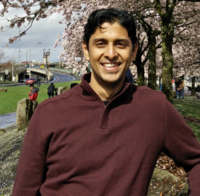CAZypedia celebrates the life of Senior Curator Emeritus Harry Gilbert, a true giant in the field, who passed away in September 2025.
CAZypedia needs your help!
We have many unassigned pages in need of Authors and Responsible Curators. See a page that's out-of-date and just needs a touch-up? - You are also welcome to become a CAZypedian. Here's how.
Scientists at all career stages, including students, are welcome to contribute.
Learn more about CAZypedia's misson here and in this article. Totally new to the CAZy classification? Read this first.
Difference between revisions of "User:Vivek Bharadwaj"
Harry Brumer (talk | contribs) (Created page with "200px|right '''This is an empty template to help you get started with composing your User page.''' You should begin by opening this page for ed...") |
Harry Brumer (talk | contribs) m (cleaned-up page) |
||
| (6 intermediate revisions by 2 users not shown) | |||
| Line 1: | Line 1: | ||
| − | [[ | + | [[File:DP.png|200px|right]] |
| − | |||
| − | + | Dr. Vivek S. Bharadwaj is a Staff-Scientist at the Bioenergy Science and Technology (BEST) Directorate of the National Renewable Energy Laboratory (NREL) in Golden, Colorado. His research focuses on using computational molecular science to improve the economic viability of biochemical and thermochemical biomass valorization platforms. He joined NREL as a post-doctoral researcher in 2015 after obtaining his doctorate in Chemical Engineering from the Colorado School of Mines, where he studied hydrocarbon biodegradation and solvation of biomass components in ionic liquids. | |
| − | + | Vivek has contributed to the CAZY community since 2015 with his work on molecular modeling using to fill knowledge-gaps that are intractable with experiments. His work has involved using ''in silico'' docking simulations in conjunction with more rigorous molecular dynamics and quantum mechanics simulations to bridge structural biology data with biochemical data and illuminate the mechanistic underpinnings of [[Glycosyltransferase Family 37]] <cite>vsb2017</cite> and [[Glycoside Hydrolase Family 45]] <cite>vsb2020</cite> CAZymes. | |
| − | |||
| − | |||
| − | |||
| − | |||
| + | ---- | ||
| + | <biblio> | ||
| − | + | #vsb2020 pmid=32054684 | |
| − | + | #vsb2017 pmid=28670741 | |
| − | # | ||
</biblio> | </biblio> | ||
| − | |||
<!-- Do not remove this Category tag --> | <!-- Do not remove this Category tag --> | ||
[[Category:Contributors|Bharadwaj,Vivek]] | [[Category:Contributors|Bharadwaj,Vivek]] | ||
Latest revision as of 08:13, 2 December 2022
Dr. Vivek S. Bharadwaj is a Staff-Scientist at the Bioenergy Science and Technology (BEST) Directorate of the National Renewable Energy Laboratory (NREL) in Golden, Colorado. His research focuses on using computational molecular science to improve the economic viability of biochemical and thermochemical biomass valorization platforms. He joined NREL as a post-doctoral researcher in 2015 after obtaining his doctorate in Chemical Engineering from the Colorado School of Mines, where he studied hydrocarbon biodegradation and solvation of biomass components in ionic liquids.
Vivek has contributed to the CAZY community since 2015 with his work on molecular modeling using to fill knowledge-gaps that are intractable with experiments. His work has involved using in silico docking simulations in conjunction with more rigorous molecular dynamics and quantum mechanics simulations to bridge structural biology data with biochemical data and illuminate the mechanistic underpinnings of Glycosyltransferase Family 37 [1] and Glycoside Hydrolase Family 45 [2] CAZymes.
- Urbanowicz BR, Bharadwaj VS, Alahuhta M, Peña MJ, Lunin VV, Bomble YJ, Wang S, Yang JY, Tuomivaara ST, Himmel ME, Moremen KW, York WS, and Crowley MF. (2017). Structural, mutagenic and in silico studies of xyloglucan fucosylation in Arabidopsis thaliana suggest a water-mediated mechanism. Plant J. 2017;91(6):931-949. DOI:10.1111/tpj.13628 |
- Bharadwaj VS, Knott BC, Ståhlberg J, Beckham GT, and Crowley MF. (2020). The hydrolysis mechanism of a GH45 cellulase and its potential relation to lytic transglycosylase and expansin function. J Biol Chem. 2020;295(14):4477-4487. DOI:10.1074/jbc.RA119.011406 |
